Loblaw Companies Bundle
How Did Loblaw Become Canada's Retail Titan?
Journey back in time to explore the Loblaw Companies SWOT Analysis and uncover the remarkable story of Loblaw, Canada's leading supermarket chain. From its humble beginnings in 1919, this iconic brand revolutionized the Canadian grocery landscape. Discover the pivotal moments that shaped Loblaw's evolution and its enduring impact on the nation's food industry.
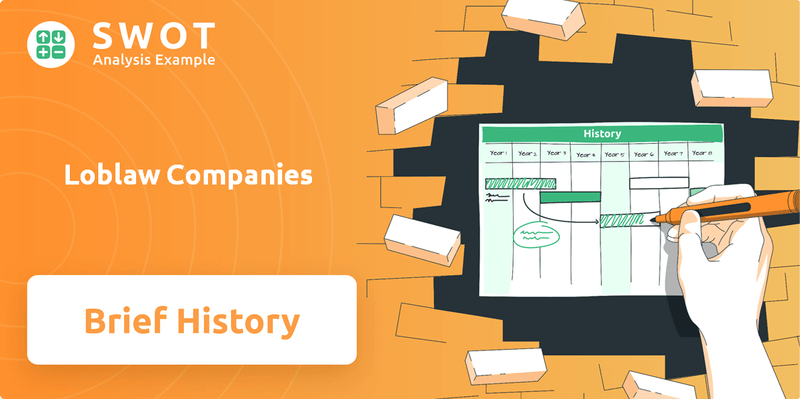
This brief history of Loblaw Companies Limited will delve into the company's founding, tracing its roots from Loblaw Groceterias in Toronto. Learn about the strategic shifts and key acquisitions that fueled its growth, including its relationship with George Weston Limited. We will also examine how Loblaw's early years and expansion timeline contributed to its current status as a multifaceted retail giant, exploring its vast network of store locations across Canada and its significant role in the Canadian grocery market.
What is the Loblaw Companies Founding Story?
The story of Loblaw Companies' beginning is a tale of innovation in the Canadian grocery sector. Founded in June 1919, the company emerged from a vision to modernize the traditional shopping experience. This founding marked the start of a journey that would reshape how Canadians purchase groceries.
Theodore Pringle Loblaw and J. Milton Cork, the company's founders, saw an opportunity to improve the efficiency of grocery shopping. Their solution was a groundbreaking 'self-serve, cash-and-carry' model, a departure from the conventional, clerk-assisted stores. This shift aimed to provide customers with better products at more affordable prices.
The initial Loblaw Groceterias store offered a wide selection of groceries, pioneering the self-service concept in Canada. This approach quickly gained popularity, leading to rapid expansion. The founders were initially met with skepticism, but their model proved successful. The name, Loblaw Groceterias, reflected the founders' names and the innovative self-service format. While specific initial funding details are not widely available, the company's early success and reinvestment of profits fueled its growth.
The company was founded in June 1919 in Toronto, Ontario, by Theodore Pringle Loblaw and J. Milton Cork.
- The founders aimed to revolutionize the traditional grocery model.
- Their innovative 'self-serve, cash-and-carry' model allowed customers to select their own items.
- The first store offered a wide array of groceries, and the concept quickly gained traction.
- The early 20th-century context supported the growth of this new retail format.
Loblaw Companies SWOT Analysis
- Complete SWOT Breakdown
- Fully Customizable
- Editable in Excel & Word
- Professional Formatting
- Investor-Ready Format
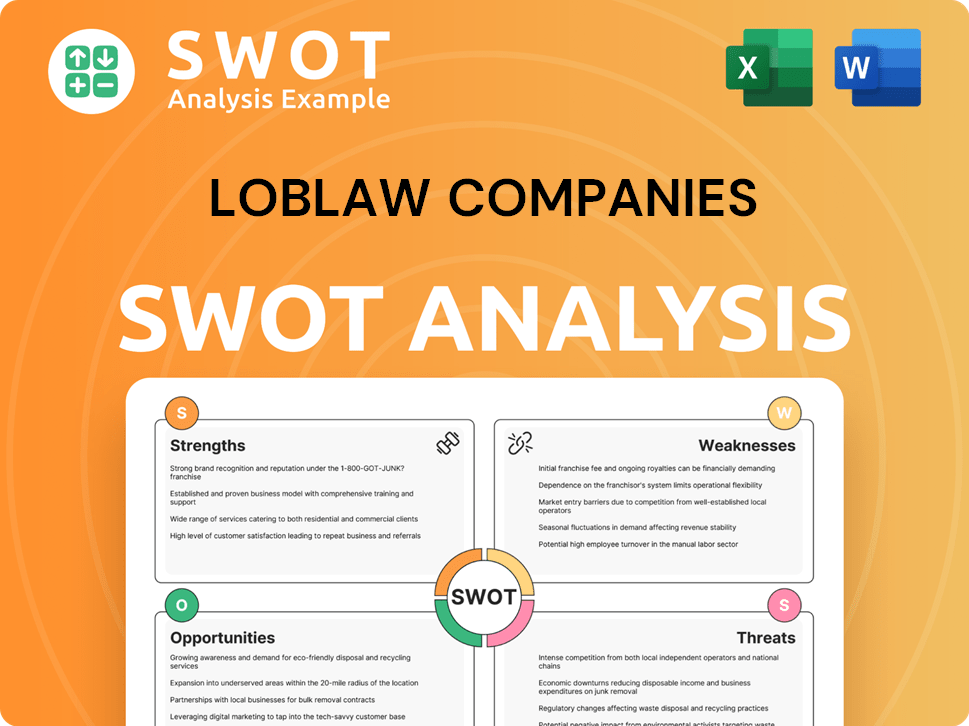
What Drove the Early Growth of Loblaw Companies?
The early years of Loblaw Companies were marked by significant growth and expansion. Following its establishment in 1919, the company quickly increased its presence across Ontario. This period saw the opening of new stores and the development of infrastructure to support its growing operations, setting the stage for its future in the Canadian grocery market.
By 1929, the company had established 87 stores in Ontario, demonstrating rapid expansion. The 1930s saw further growth, with 107 stores in Ontario and 50 in New York State. This expansion was supported by investments in infrastructure, including a new head office in Toronto.
In June 1928, a $1.5 million art deco head office opened in Toronto, which included office and warehouse space, bakeries, food-packaging facilities, a coffee roastery, and a rail connection. In 1933, many outlets were converted to 'Market Stores,' introducing full-service meat and produce departments, a first in Canada, and later, frozen food sections.
A major shift occurred in 1947 when W. Garfield Weston, president of George Weston Limited, began acquiring shares. By 1953, George Weston Limited had established majority control. In 1956, Loblaw Companies Limited was incorporated as a holding company. Learn more about the Owners & Shareholders of Loblaw Companies.
During the 1950s and 1960s, Loblaw pursued an aggressive acquisition strategy. Key acquisitions included Power Supermarkets (1953), National Grocers (1955), and Kelly Douglas and Company (1958). The company also acquired a controlling interest in the Chicago-based National Tea Co. This strategy helped Loblaw become the third-largest supermarket chain in North America at its peak.
Loblaw Companies PESTLE Analysis
- Covers All 6 PESTLE Categories
- No Research Needed – Save Hours of Work
- Built by Experts, Trusted by Consultants
- Instant Download, Ready to Use
- 100% Editable, Fully Customizable
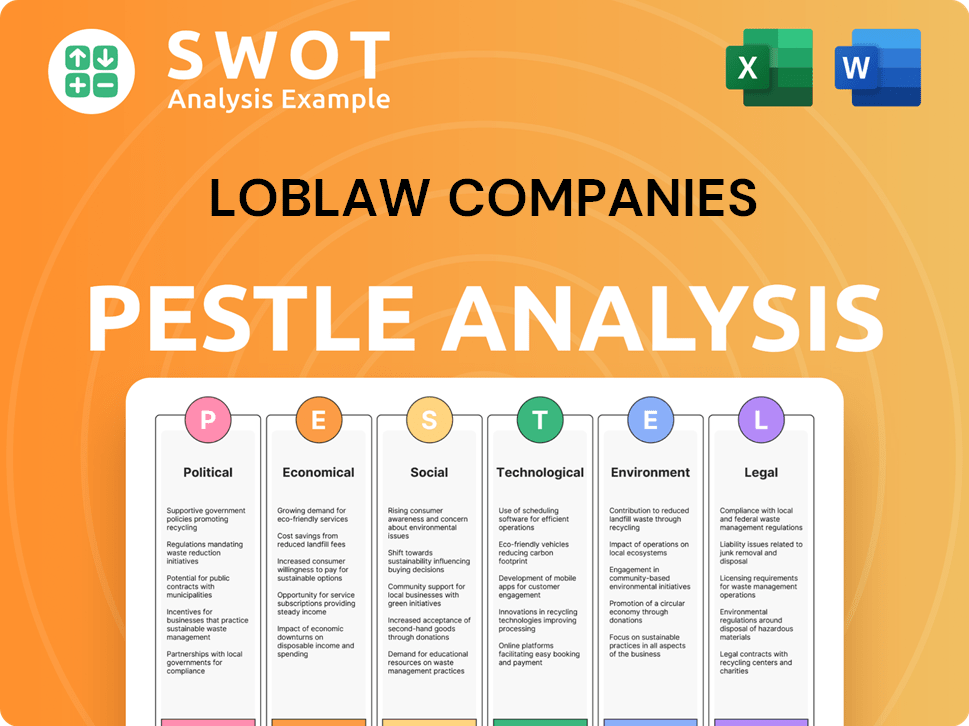
What are the key Milestones in Loblaw Companies history?
The Loblaw Companies has a rich Loblaw history, marked by strategic shifts and significant growth within the Canadian grocery market. From overcoming financial crises to expanding its retail footprint, the company has consistently adapted to the evolving demands of consumers and the competitive pressures of the industry. Understanding the key milestones provides insight into the company's resilience and its enduring influence on Loblaw's role in Canadian retail.
| Year | Milestone |
|---|---|
| 1972 | W. Galen Weston appointed CEO, initiating a turnaround strategy. |
| 1978 | Launched the 'No Name' generic product line, offering affordable options. |
| 1979 | Pioneered the 'superstore' format with the SuperValu banner in Western Canada. |
| 1983 | Introduced the 'President's Choice' premium house brand, a significant revenue driver. |
| 1998 | Acquired Provigo, Inc. in Quebec, expanding its market presence. |
| 2014 | Acquired Shoppers Drug Mart for C$12.4 billion, broadening its scope. |
| 2018 | Integrated loyalty programs to create PC Optimum. |
Loblaw Companies has consistently embraced innovation to meet changing consumer needs and maintain its competitive edge. The introduction of the 'No Name' and 'President's Choice' brands showcases its ability to create and adapt to market trends. These initiatives, along with the superstore format, demonstrate Loblaw's commitment to providing diverse offerings and value to its customers.
Launched in 1978, the 'No Name' brand offered a range of basic products at lower prices. This initiative provided consumers with affordable options, helping Loblaw capture a broader market segment. This strategy was a key element in Loblaw's early years.
Introduced in 1983, 'President's Choice' became a premium house brand, significantly boosting revenue. By the mid-1990s, it generated $1.5 billion in annual retail sales, demonstrating its success in the market.
Loblaw pioneered the 'superstore' format in 1979, combining general merchandise with a full supermarket. This innovation offered customers a one-stop shopping experience, enhancing convenience and driving sales.
The 2014 acquisition of Shoppers Drug Mart expanded Loblaw's presence in the pharmacy and health and beauty sectors. This strategic move broadened its market reach and integrated loyalty programs.
The integration of loyalty programs, creating PC Optimum in February 2018, enhanced customer engagement. This program enabled Loblaw to gather valuable customer data and personalize marketing efforts.
Recent years have seen Loblaw focus on expanding its hard discount division, with over 90 new or converted Maxi and No Frills stores launched. This expansion aims to capture the value-conscious consumer segment.
Loblaw Companies has faced several significant challenges throughout its history, requiring strategic responses to maintain its market position. The entry of Walmart into the Canadian market intensified competition, necessitating strategic acquisitions and operational adjustments. Additionally, internal issues and legal challenges, such as the bread price-fixing arrangement, have tested the company's resilience and required proactive measures to maintain consumer trust. For further insights into the company's values, explore Mission, Vision & Core Values of Loblaw Companies.
The arrival of Walmart in Canada in 1994 significantly intensified competition within the Canadian grocery market. Loblaw responded with strategic acquisitions and operational adjustments to maintain its market share.
The acquisition of Provigo in 1998, while expanding market presence, led to antitrust scrutiny. This resulted in Loblaw being forced to sell its Loeb chain to Metro-Richelieu to avoid over-concentration.
Corporate restructuring in the early 2000s led to supply chain problems, causing out-of-stock items and declining profits. These issues highlighted the need for improved operational efficiency.
Loblaw disclosed a bread price-fixing arrangement from 2000 to 2014 to the Competition Bureau in December 2017. This led to reputational damage and required significant remediation efforts.
The Canadian grocery market is highly competitive, with numerous players vying for market share. Loblaw continuously faces pressure to innovate and offer competitive pricing.
Economic factors, such as inflation and changes in consumer spending habits, pose ongoing challenges. Loblaw must adapt its strategies to address these economic realities effectively.
Loblaw Companies Business Model Canvas
- Complete 9-Block Business Model Canvas
- Effortlessly Communicate Your Business Strategy
- Investor-Ready BMC Format
- 100% Editable and Customizable
- Clear and Structured Layout
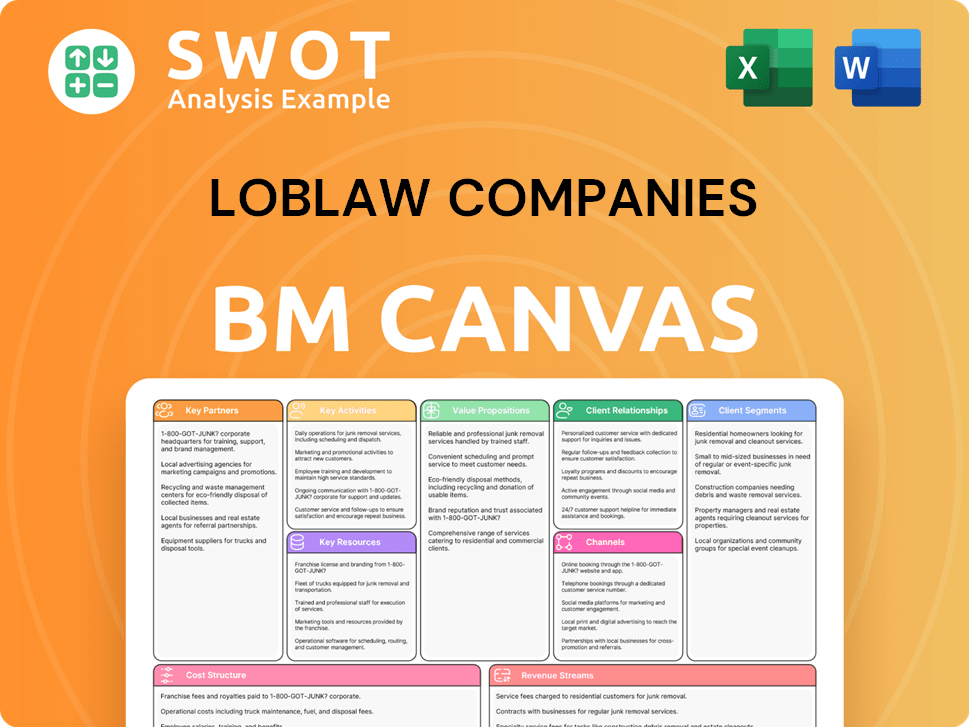
What is the Timeline of Key Events for Loblaw Companies?
The story of Loblaw Companies is a significant part of the Canadian retail landscape, marked by strategic expansions, innovative branding, and a commitment to adapting to consumer needs. From its beginnings as a small grocer to its current status as a major supermarket chain, the company has consistently evolved, reflecting the changing tastes and demands of its customers.
| Year | Key Event |
|---|---|
| 1919 | Theodore Pringle Loblaw and J. Milton Cork open the first Loblaw Groceterias in Toronto, pioneering the self-serve model. |
| 1928 | Loblaw Groceterias expands into the United States, opening stores in New York, Pennsylvania, and Illinois. |
| 1933 | 'Market Stores' are introduced, offering full-service departments for meat, produce, and later, frozen foods. |
| 1947 | W. Garfield Weston begins acquiring shares in Loblaw Groceterias. |
| 1953 | George Weston Limited gains controlling interest in Loblaw Groceterias. |
| 1956 | Loblaw Companies Limited is incorporated as a holding company. |
| 1972 | W. Galen Weston is appointed CEO, leading a major restructuring of the company. |
| 1978 | The 'No Name' line of generic products is launched, offering value to consumers. |
| 1983 | The 'President's Choice' premium house brand is introduced, enhancing product offerings. |
| 1998 | Loblaw acquires Provigo, Inc. in Quebec for approximately C$1.74 billion. |
| 2006 | Galen G. Weston is appointed Executive Chairman of Loblaw Companies. |
| 2013 | Choice Properties REIT, a real estate investment trust, holds a CA$400 million IPO, with Loblaw retaining majority ownership. |
| 2014 | Loblaw acquires Shoppers Drug Mart for C$12.4 billion. |
| 2018 | The Shoppers Optimum and PC Plus loyalty programs merge to create PC Optimum. |
| 2020 | Loblaw acquires Eyereturn Marketing in November. |
| 2022 | Loblaw acquires Lifemark Health Group, expanding into healthcare services. |
| 2023 | Per Bank is named the successor to Galen Weston as President and CEO, joining in early 2024. |
| 2024 | Loblaw announces a $2 billion CAD investment to enhance its store network, including over 40 new discount stores and 140 new pharmacy care clinics. |
| 2025 | Loblaw plans to open approximately 80 new stores and 100 new clinics, including a second T&T Supermarket in downtown Toronto. |
The company is set to reinvest over $10 billion into the Canadian economy over the next five years. This investment includes the opening of approximately 80 new stores and 100 pharmacist care clinics in 2025. These initiatives aim to boost store networks, create jobs, and improve access to affordable food and healthcare for Canadians.
Loblaw is expanding its T&T brand into the U.S. market, starting with a successful opening in Seattle. The company is also focusing on increasing its hard discount store formats (No Frills and Maxi). This strategy is designed to drive higher sales volumes and tap into new geographic markets, which is expected to significantly boost revenues.
Loblaw is investing in supply chain efficiencies, including a new 1.2 million square foot fully automated distribution center. The company is also enhancing digital engagement and online sales, which grew by 18.4% in a recent quarter. These improvements aim to streamline operations and meet the growing demand for online grocery shopping.
Analysts project Loblaw Companies' revenue to grow by 3.5% annually over the next three years, with earnings reaching CA$2.3 billion by May 2028. These projections indicate a positive financial outlook for the company, reflecting its strategic investments and market strategies. These forward-looking strategies tie back to the founding vision of providing value and convenience to Canadians.
Loblaw Companies Porter's Five Forces Analysis
- Covers All 5 Competitive Forces in Detail
- Structured for Consultants, Students, and Founders
- 100% Editable in Microsoft Word & Excel
- Instant Digital Download – Use Immediately
- Compatible with Mac & PC – Fully Unlocked
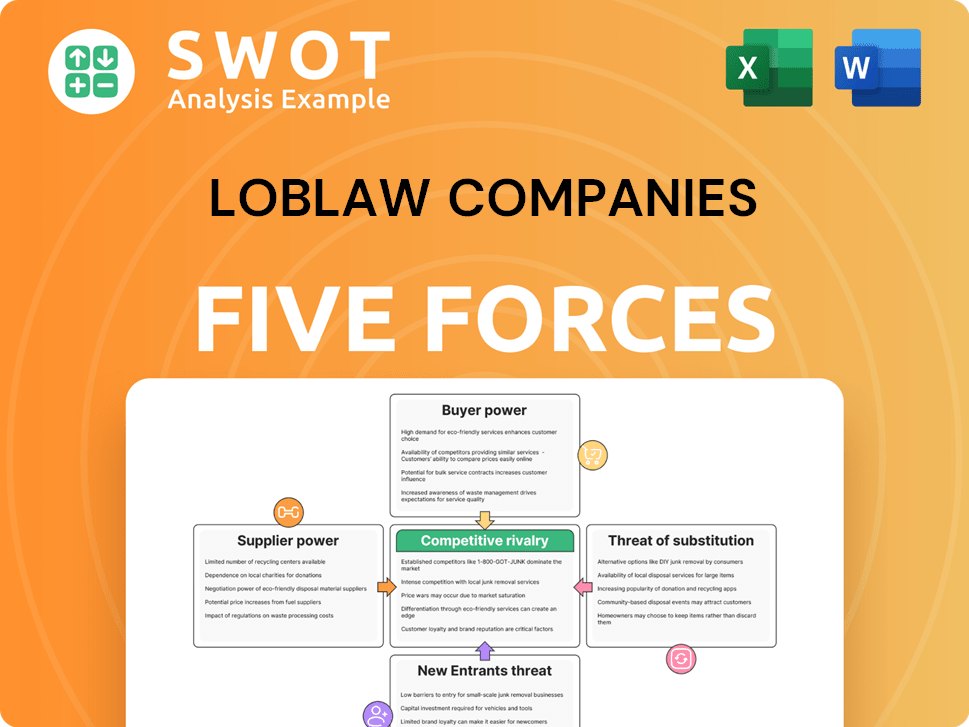
Related Blogs
- What is Competitive Landscape of Loblaw Companies Company?
- What is Growth Strategy and Future Prospects of Loblaw Companies Company?
- How Does Loblaw Companies Company Work?
- What is Sales and Marketing Strategy of Loblaw Companies Company?
- What is Brief History of Loblaw Companies Company?
- Who Owns Loblaw Companies Company?
- What is Customer Demographics and Target Market of Loblaw Companies Company?
Disclaimer
All information, articles, and product details provided on this website are for general informational and educational purposes only. We do not claim any ownership over, nor do we intend to infringe upon, any trademarks, copyrights, logos, brand names, or other intellectual property mentioned or depicted on this site. Such intellectual property remains the property of its respective owners, and any references here are made solely for identification or informational purposes, without implying any affiliation, endorsement, or partnership.
We make no representations or warranties, express or implied, regarding the accuracy, completeness, or suitability of any content or products presented. Nothing on this website should be construed as legal, tax, investment, financial, medical, or other professional advice. In addition, no part of this site—including articles or product references—constitutes a solicitation, recommendation, endorsement, advertisement, or offer to buy or sell any securities, franchises, or other financial instruments, particularly in jurisdictions where such activity would be unlawful.
All content is of a general nature and may not address the specific circumstances of any individual or entity. It is not a substitute for professional advice or services. Any actions you take based on the information provided here are strictly at your own risk. You accept full responsibility for any decisions or outcomes arising from your use of this website and agree to release us from any liability in connection with your use of, or reliance upon, the content or products found herein.